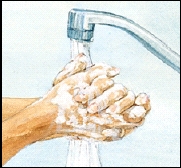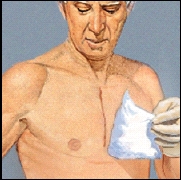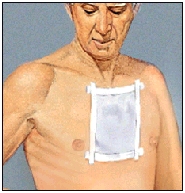Incision Care: Chest
Incision Care: Chest
Dressing your incision helps keep it clean, dry, and free of infection. That way it will heal faster. Your incision may be open to the air by the time you go home. But if you need to change your dressing, follow the steps below.
1 |
2 |
3 |
Step 1. Wash your hands and set up
Use liquid soap. Lather for 1 or 2 minutes. Scrub between your fingers and under your nails.
Rinse with warm water, keeping fingers pointing down. Use a clean towel to dry your hands and turn off the faucet.
Put all your supplies on a clean cloth or paper towel. Open a plastic trash bag.
Peel back the edges of the dressing packages.
Clean the scissors with soap and water. Cut each piece of tape 4 inches longer than the dressing.
Step 2. Remove the old dressing
Put on disposable gloves.
Loosen the tape by pulling gently toward the incision. Remove the dressing one layer at a time.
Look at the dressing to see if there is any drainage. If you see drainage, call your healthcare provider if:
You see more or less drainage than before
The color of the drainage has changed
The drainage has an odor or smells bad
Put the dressing into a zip-top plastic bag.
Remove your gloves, put them in the zip-top plastic bag, and seal the bag.
Wash your hands. Then put on new gloves.
Step 3. Clean and dress the incision
Gently clean the incision with soap and water. Or use another solution if your doctor tells you to.
Don't scrub the incision. Wipe it gently.
Pat the incision dry.
Don't use any creams, lotions, or antibacterial ointments unless your doctor tells you to.
Look at the incision to see if it is still closed.
Look for any redness or swelling around the incision.
Put all used supplies in a zip-top plastic bag.
Remove your gloves and put them in the zip-top plastic bag. Seal the bag and put it in the trash.
Wash your hands again.
When to call your healthcare provider
Call your healthcare provider right away if you have any of the following:
Bleeding from the incision, or an opening of the incision where it had been closed
Increased redness, swelling, or pain in or around the incision
Increased drainage or foul-smelling drainage. It doesn't matter what the color is.
Change in the color of the incision
Fever of 100.4°F (38°C) or higher, or as directed by your healthcare provider
Updated:
May 09, 2017
Sources:
2011 the American College of Cardiology Foundation/American Heart Association Guideline for Coronary Artery Bypass Graft Surgery. Hills, L. Journal of the American College of Cardiology. 2011, is. 58, ed. 24, pp. s123-210., Patient information: Recovery after coronary artery bypass graft surgery (CABG) (Beyond the Basics). UpToDate.
Reviewed By:
Fetterman, Anne, RN, BSN,Mancini, Mary, MD,Pierce-Smith, Daphne, RN, MSN, CCRC


